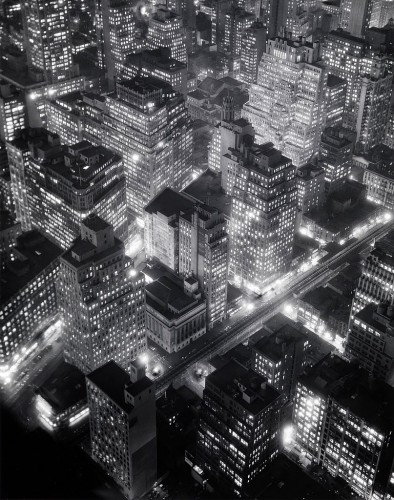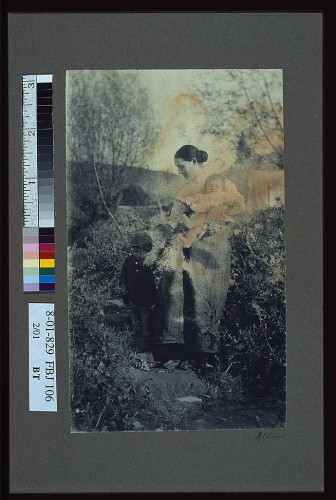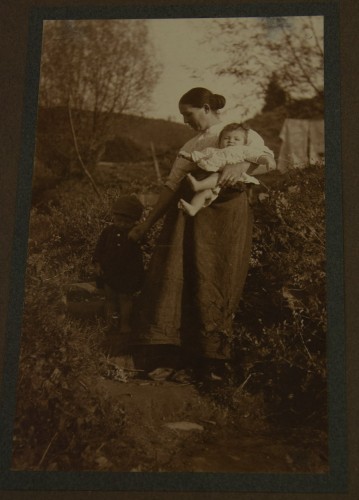I’ve been using the Library of Congress Photo Archives a lot recently to find copies of photos by early 20th century American women photographers. The LOC has a fair number of works by those women available, many of which have been digitized and made available online. That’s been very handy. However, as I was preparing for a talk at the university here last month about Frances Benjamin Johnston, who worked as a professional photographer starting in 1891, I noticed that while most of her works are freely available for download from the LOC site, not all of the works by her contemporaries are. Many of them are listed as digitized in the catalog, but you can’t download copies of them unless you’re physically at a computer in the Library of Congress office.
I found that curious. So, without a lot of prior planning, I set off on a trip to the LOC last week to see what I could find out. Chris and I were staying in Baltimore for his conference, and Washington, DC is only a short 50-minute, $7 commuter-train ride away from Baltimore.
Once registered — I now have an official researcher’s library card for the LOC! — I found the Prints and Photographs archives and headed in.
BTW, the P&P archives are in the Madison Building, which is a building around the corner from the Jefferson building and that big fountain. The buildings are connected via underground tunnels on the “G*” floor. I accidentally found that out, since in order to get out of the Madison building at the end of the day, I needed to remember that in the U.S., it’s the first floor (“1”) in the elevator that gets you to street level, unlike in Europe where it’s “G”. In the Madison building, if you go to “G” and look for the exit, there isn’t one. Very confusing when you’ve been living in Europe for the past 6 years. I’m just saying…
But I digress. The P&P staff were very friendly, although unable to offer a satisfactory explanation about why those photos are blocked from being downloaded if you’re not on site. From what they said, I think it’s probably just a case of having no staff available to review them in order to get them released for general download, since the photos should be long out of copyright. But these female photographers don’t get talked about much — or, really, at all — in most history books, so it’s not going to be a top priority to get them reviewed and updated in the LOC catalog.
However, as I mentioned, it is possible to download those images when you’re there. So I spent the better part of two days downloading images to take back with me to have on hand for future lectures, etc.
Of course, a different and really fun thing to do at the LOC archives is to ask the staff to go pull items off the shelves in the storage, so you can see famous prints in person and/or get access to items that have never been digitally scanned.
I didn’t have a lot of time after my downloading, but I was able to spent some time looking at a portfolio of images by Berenice Abbott, one of my favorite early 20th century photographers. In person, her Night View image is truly spectacular; the shading of darks and lights, the clarity of all those buildings in the entire print – amazing! She was really masterful in figuring out how to get that just right. The digital version that I use for teaching is impressive, but doesn’t really do her work justice:
So, that was fun, getting to see original works. I also took a little time to explore differences between various version of the same print that were in the archives. For example, while downloading images by Frances S. Allen, a rather obscure American woman photographer ca. 1900, I noticed that there was a digitized version of a print of her work called The Difficult Step; the digitized version had clearly been damaged at some point in time when something spilled on it. However, the catalog also listed another version of that same photo, but the other one had never been digitized. The friendly staff member helping me was curious as to why I’d want to see both, particularly because in this instance, the digitized version had a clear flaw in it, and therefore the staff didn’t think it would be that interesting to see in person.
However, when you compare the two images side-by-side in person, it’s easier to appreciate all of the pictorialist-style techniques that Ms. Allen employed to create other print. Pictorialist photographers start with a black and white image, and then in the final print alter it, perhaps making it sepia, softening the focus, changing the contrast and highlights, cropping it, etc. The final pictorialist print is what shows their artisty, not the original black and white photo. Interestingly, though, the digitized (and damaged) copy is just the black and white original photo; it is the undigitized copy that is really the pictorialist artwork by Ms. Allen.
So, it fun to see the difference and also to show it to the staff member who was helping me, since he’s not an expert on Pictorialism; the woman who is wasn’t in the office that day. However, discovering that also then raised the obvious point that there could be a lot of works that need to be explored beyond what’s been already digitized in the LOC catalog. What a fun treasure hunt to do someday! I unfortunately didn’t have much time on this visit to do that kind of thing, as I was busy with all those downloads I needed to do for future projects and lectures.
But I’m certain there a lot of hidden gems sitting in those archives, just waiting to be found, whenever I can get back to the LOC. Someday.
P.S. Watch for my Monday Mysteries post next Monday. Although I didn’t look at much that of the non-digitized works, I did accidentally stumble onto a fabulous photo that raises some intriguing questions. Stay tuned…




Great project! Here’s hoping it leads to your next book!
fascinated by the NYC photo by Berenice Abbot. The difference between the digitalized and non digitalized version of The Difficult Step, by Frances S. Allen is amazing.
@Will, yes, me, too! 🙂
@Kathy, that’s one of my favorite photos by Berenice Abbott. She plotted and planned that shot for the better part of a year. It was a long exposure from high-up, and she wanted as many of the lights in the office building on when she took the photo. So, there was only 1 day in the year (or so she later wrote) when workers would in the offices long enough after sunset to have all lights on and give her time for the long exposure, before they started going home (and turning the lights out). Amazing planning and figuring out what to do for the technical side of that shot in general, too.